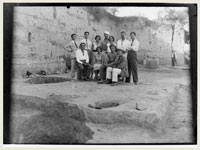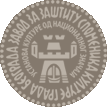|
| |
| |

ДВОЈНА ФИГУРИНА
|
| |

ГРУПА ИСТРАЖИВАЧА СА ПРОФ. МИЛОЈЕМ ВАСИЋЕМ
|
| |

АРХЕОЛОШКА ИСКОПАВАЊА, 1908-1911.
|
| |

ВАЗА ПОТИСКЕ КУЛТУРЕ ИЗ ВИНЧЕ
|
| |

СТРАТИГРАФИЈА ВИНЧЕ – ПРОФИЛ (ВИСИНЕ 10,5 m) СА ОСТАЦИМА КУЛТУРНИХ СЛОЈЕВА
|
| |
 |
 |
| |
|
|
|
|

ОПШТИ ИЗГЛЕД ЛОКАЛИТЕТА
|
|
| |
| |
Archaeological site of outstanding value
Belo brdo,
Vinča
Археолошко налазиште од изузетног значаја
Бело брдо,
Винча |
|
|
|
|
|
| The famous archeological site on the bank of the Danube is one of the oldest human settlements. The fertile ground, the vicinity of a large river rich in fish and cinnabar provided good conditions for a long and continuous dwelling on the woody terrace over the Danube. The protracted human presence created rich prehistoric layers that formed a tell that surmounts the surrounding area. The thickness of the found cultural stratum is 10.5 meters, the largest archeological profile found in Serbia. Many prehistoric settlements have been found of which the oldest (containing remnants of dug-outs and characteristic ceramics) dates from the time of the Starčevo culture (10.5-9.1 m). The Vinča culture (Vinča-Tordoš and Vinča-Pločnik, 9.1-3 meters) is represented by the remnants of houses, a large number of ceramic vessels and highly important findings of Neolithic plastic, stone axes and various tools made from bone. The archeological remnants of later epochs, mixed with the Neolithic ones could be found in the top layer (3-0 meters). Chronologically, the last findings are related to the Middle Ages. From the eighth to the seventeenth century this area was used as a burial ground. |
| |
 |
| |
 |
| |
|
|
|
| |
| Познати археолошки локалитет на обали Дунава, једно је од најстаријих људских станишта. Плодно земљиште, непосредна близина велике реке богате рибом и рудишта цинабарита погодовали су континуираном живљењу на лесној тераси над Дунавом. Дебљина констатованог културног слоја износи 10.5 m, што представља највећи археолошки профил откривен у Србији. У њему се може издвојити више праисторијских насеља од којих најстарије датира још из времена старчевачке културе (10.5 до 9.1 m), са остацима земуница и карактеристичном керамиком. У вишим слојевима нађени су остаци винчанске културе, Винча-Тордош и Винча-Плочник (9.1 до 3 m) у којима су заступљени остаци кућа, бројни керамички судови, значајни налази неолитске пластике, камене секире и разноврсни коштани алат. У горњем слоју (3 до 0 m) наилази се на археолошке остатке каснијих епоха. Хронолошки, последњи налази везани су за раздобље од VIII до XVII века, када је терен коришћен за сахрањивање. |
| |
Службени гласник СРС бр. 14/79
Службени гласник РС бр. 71/09
|
|
|
| |
|
|
|
|
|
|
|
|
|
|
|